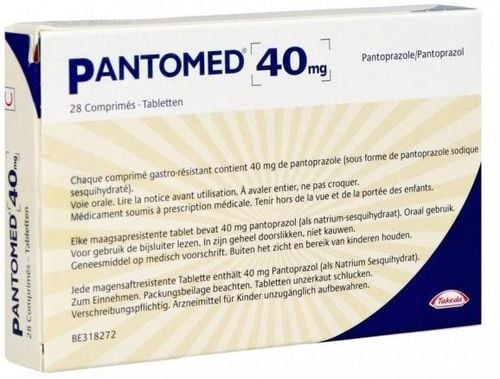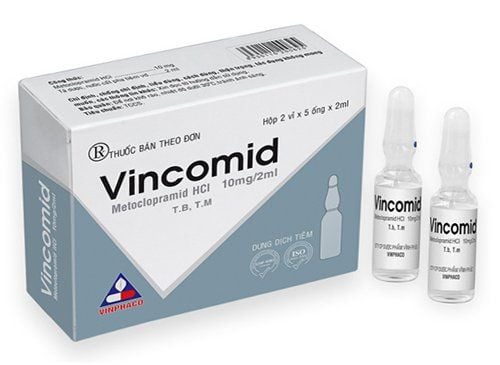This is an automatically translated article.
Degas drugs are manufactured and registered by Vinh Phuc Pharmaceutical Joint Stock Company, belonging to the group of gastrointestinal drugs. So what are the effects of Degas, indicated and used in what cases?
1. What is Degas drug?
Degas medicine has the main ingredient containing the active ingredient Ondansetron (in the form of Ondansetron HCl) with a concentration of 8mg / 4ml, made in the form of an injection solution, Degas packed in a box of 1 blister or 2 blisters, 1 blister with 5 ampoules with 4ml capacity.
2. Effects of Degas
Effects of Degas:
Active ingredient Ondansetron is a highly selective 5-HT3 receptor antagonist that helps prevent nausea and vomiting. Radiation and chemotherapy can induce the vomiting reflex by activating the vagus nerve via the 5HT receptor. Ondansetron in Degas inhibits the initiation of the upper reflex, the activation of the vagus nerve that promotes vomiting through a central mechanism by causing the release of 5HT receptors in the postrema region above the floor of the ventricles. IV. The exact mechanism of action of Degas in the control of vomiting is unknown. However, Degas is used to prevent nausea and vomiting in cancer treatment, and Ondansetron's anti-nausea and vomiting effects are due to antagonism of 5HT3 receptors on the central nervous system and peripheral nerves.
3. Indication of the drug Degas
Use Degas in the prevention of nausea and vomiting in cancer chemotherapy (especially Cisplatin) when the patient has many side effects or the patient is resistant to other conventional antiemetic therapies. Prevention of nausea and vomiting in radiation therapy for cancer. In addition, Degas is also used to prevent vomiting or nausea after surgery.
4. Contraindications to Degas
Degas should not be used in cases of hypersensitivity to the active ingredient Ondansetron, the excipients contained in the drug, or to any drug of the 5-HT3 receptor antagonist class.
5. Usage and dosage of Degas
Usage:
Degas drug is used in intramuscular or intravenous injection. Dosage to prevent vomiting in radiotherapy and chemotherapy:
Adults: The use of different chemicals with different doses, whether or not in combination and depending on the sensitivity to Each patient will have a different ability to induce vomiting. Dosage of Degas depends on the individual, using from 8 to 32 mg/day intravenously. The usual dose used is 8mg, given slowly intravenously just before chemotherapy or radiation. For chemotherapy patients who cause vomiting a lot, the dosage regimens can be used in the first 24 hours of chemotherapy as follows: Immediately before chemotherapy, inject a single dose of 8mg of Degas into a vein, slow injection. Inject the same dose as above, then add 8mg IV in 2 doses 2 to 4 hours apart or give the patient 1mg/hour continuously for 24 hours. The solution for infusion consists of a single dose of 32g Degas mixed with 50-100ml to be infused into the patient over a period of at least 15 minutes immediately before chemotherapy. Depending on the degree of vomiting of chemotherapy drugs, the appropriate treatment regimen will be selected. Children from 4 to 12 years old: Use a dose of 0.15mg/kg body weight, intravenously just before chemotherapy, then 4mg every 12 hours for no more than 5 days. For children under 3 years of age: Not indicated for use. Prevention of nausea and vomiting for patients after surgery:
Adults and the elderly: when pre-anesthesia, use Degas with a single dose of 4mg, intramuscular or slow intravenous injection. Children over 2 years: Inject 0.1 mg/kg body weight, up to 4 mg, by slow intravenous injection before, during or after pre-anesthesia. In patients with cirrhosis or liver disease, the maximum daily dose of 8mg is used.
6. Undesirable effects
When using Degas, patients may experience the following common side effects: fever, headache, sedation, diarrhea, constipation. Less common side effects include: dry mouth, dizziness, feeling weak, abdominal cramps, transient elevation of liver enzymes. And other more rare but possible side effects with Degas: Anaphylaxis, hypersensitivity reactions, hypotension, angioedema, urticaria, dyspnea, bronchospasm, wheezing wheezing, shortness of breath, tachycardia, chest pain, arrhythmia. Purpura, rash, hypokalemia, jaundice, liver enzyme disorders. If any side effects occur, it is necessary to notify the doctor or qualified medical staff for timely and effective treatment.
7. Drug interactions
Some drug interactions have been reported when using Degas with other drugs such as:
Active ingredient Ondansetron due to metabolic changes may cause increased toxicity if Degas is combined with cytochrome P450 inhibitors such as: Cimetidine , Disulfiram , Allopurinol . When using drugs that induce cytochrome P450 such as Carbamazepine, Barbiturates, Phenytoin, Rifampin, Phenylbutazone with Degas, due to changes in drug clearance, it will reduce the effect of Ondansetron active ingredient in the drug. Do not mix Degas with any solution until compatibility has been determined (especially alkaline solutions that can cause precipitation). It is recommended that patients should inform their doctor of all drugs or functional foods that have been used and are being used for appropriate, safe and effective treatment indications.
8. Pay attention to the use of Degas
For pregnant women and lactating mothers: Degas is not indicated, but if it is really necessary, you will have to follow the doctor's instructions and weigh the benefits and risks. risk of use. It is necessary to warn about unwanted effects such as headache, dizziness, which may affect the patient's ability to drive and use machines. Above are the uses, doses and notes when using Degas medicine. To ensure the safety of your health and maximize the effectiveness of treatment, you need to take the medicine exactly as directed by your doctor.
Please dial HOTLINE for more information or register for an appointment HERE. Download MyVinmec app to make appointments faster and to manage your bookings easily.













